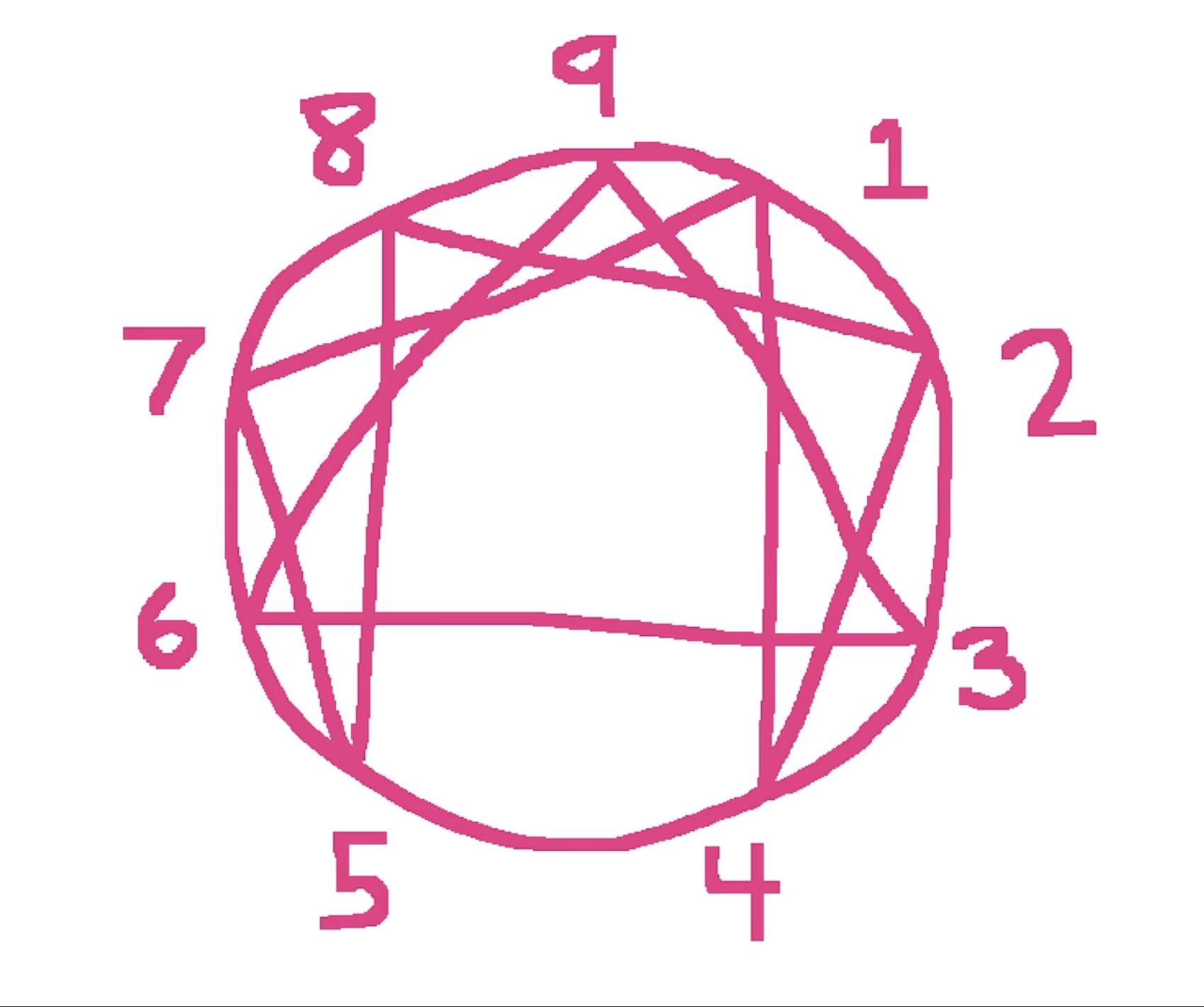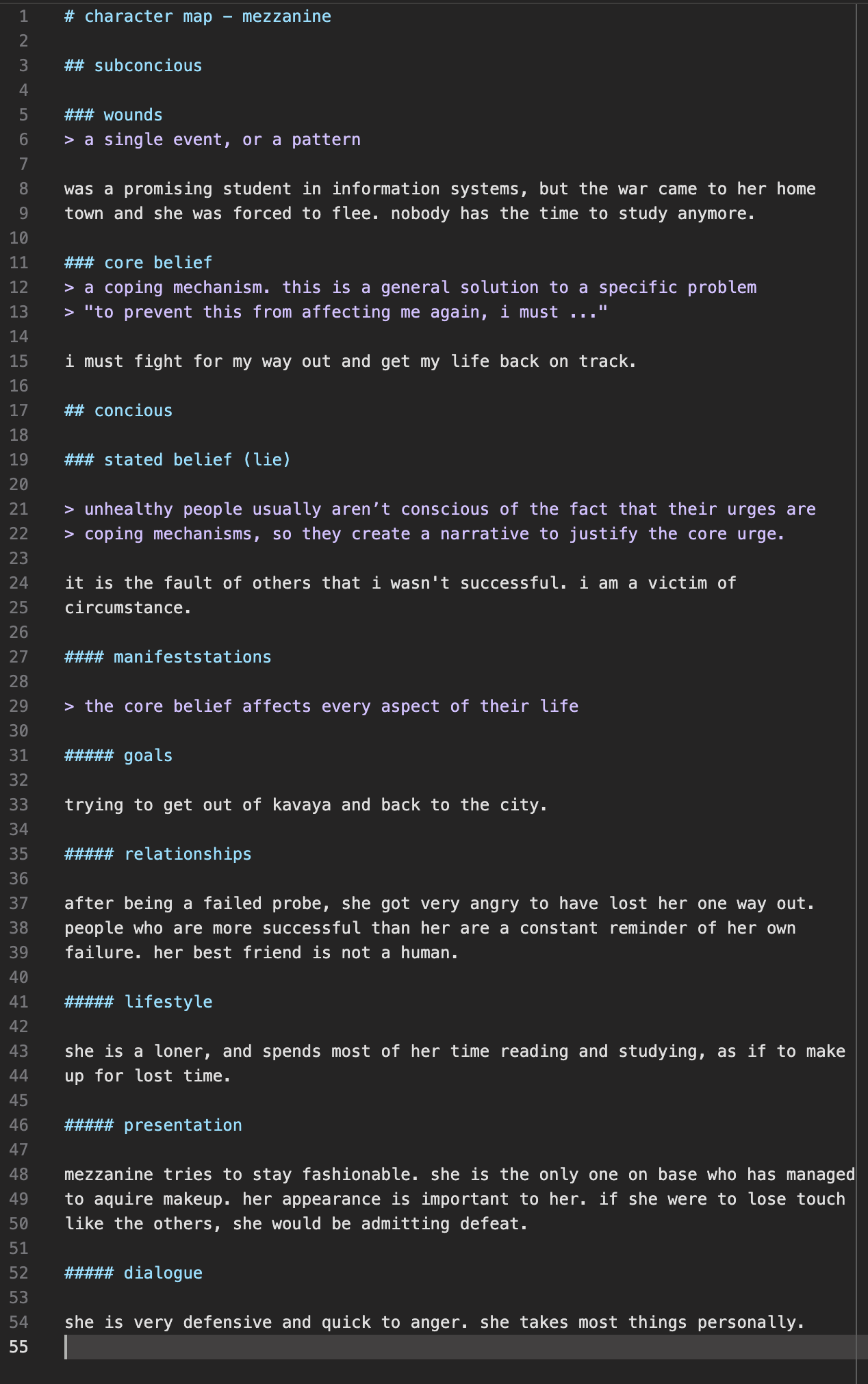Mailbag #4: “Enneagram”
Be efficient, or burn out ~ Let's be pseuds together
ok so, you want to write that thing that exists in your head. it might be a particular scene, a dynamic between two people, or a world so massive that every political intrigue is explored in great detail. you have ideas, but you have no idea how to combine them without the elements becoming disjointed. how do you make a character that feels real? what about their relationships to other characters? can you even be methodical about this? how do?
i think some people have a natural knack for playing house. you smash your dolls together and something comes out. i know myself i’ve been far from methodical, mostly just relying on vibes and for the wind to blow in the right direction. i’ve previously described my approach as writing characters as if they are a facet of my own personality. girls that are some little interesting thing, exaggerated to the point of being a character. sometimes it works, but it’s not a formula.
i’ve been stuck in the trenches of trying to write kavaya local maximum. every time i try and conceptualize a character, they fit neatly into a plot, but not into the overall fabric of the story. i kept rewriting, but i feel like the improvement was marginal. cacophany in every direction. a big project is challenging. i was frustrated, losing confidence in my abilities. i was about ready to give up several times, thinking that i’ve bit off more than i could chew.
i’m going to sing the praises of a youtuber for the rest of this post
recently, i stumbled upon a series of youtube videos created by localscriptman, a allegedly successful author with somewhat anonymous credentials, who i will be referring to as lucas.1 i might be exposing myself as someone who’s not particularly read, but i kind of hate this shit usually. nobody has ever communicated what i actually like about storytelling, or said something i didn’t already know ~ i’m pretty resistant to new opinions because i want to cling to my own flavor, lest it be lost to something more formulaic (honestly – a completely terrifying prospect to me). i was skeptical of new advice, but i’ve been feeling especially desperate for things to work out recently so, i clicked.2
i have to admit it is some real shit to me. looking past the youtuber affect, he has said enough good things that i was able to reframe my approach to writing characters with only his advice. really, this guy could be a revered academic. he’s an excellent communicator. mostly because of him, i’ve been able to make sense of the story i wanted to tell. things are working great after i learned just a few tricks. maybe i was full of shit the whole time. (backslides)
i’d like to share some of the insights i’ve gained from these videos. an overall thesis is spread out over a series of his videos, but i’ll try to condense it into a few nuggets of wisdom, relating it to my own experiences. honestly, you can stop here if you want. watch some of whatever interests you on his channel. he will explain it way better than i could have. if you like my writing and want to do it too, i think there is something for you here.
lesson: characters are not people
you can get caught up in the idea that you need to make a character that is fully bodied. your creation demands to be treated with dignity. if they do things that are out of character, then you’re not being true to them, and more importantly– you’re not being true to yourself.
i’m sentimental about my characters. i love them. but this love has been a barrier for me to write confidently. i’ve been afraid to make them do things that are out of character, because i’m afraid of betraying them, or some idea of them that i want to protect. sometimes it’s an idea of a past self. hoarder house.
if a plot element is a certain way, then it creates a restriction in the story. a character can’t do things that is outside of the established canon, because that would betray the nature of the work. the environment must let itself be known in a specific way, or it betrays the nature of the world. if ranka could cast fireball, wouldn’t that kill a lot of the tension of her as a helpless character? it’s a stupid example, but the point is that too many of these restrictions creates tension in your story. not tension like tense, but tension like a rubber band. it’s going to snap.
your restrictions must work together for the story to find harmony. if something goes against the grain, then you must not be afraid of killing your darlings. sometimes, it is necessary to make a sacrifice so that the story can be told.
being out of character is simply your mind pulling you into an interesting direction. pull the thread. you might end up reeling in something that is more interesting than what you had planned. sometimes sacrifices like this are necessary to better the story. it doesn’t mean you’re betraying your intentions.
lesson: the enneagram3

personality tests notoriously have a way of tickling your ego, and the enneagram is no exception. it’s a system of nine personality types, each with their own motivations, fears, and desires. everything lines up in perfect geometric harmony, so you know what kinds of personalities you’re compatible with. you know how this works already, because you’ve probably taken the myers-briggs test, or the big five, or the color code, or whatever else. if you didn’t venture out and do it yourself, you’ve probably been subjected to it by someone else who thinks they’ve cracked to code to understanding people. psychopaths, all of them.
i’m not here to talk to you about how you can use the enneagram to better understand yourself or your relationships to others, and neither would lucas. instead, we use it to analyze about fake people. let’s chat about characters.
your characters can be understood through the framework of being a type 1 through 9 on the enneagram. each type has a core motivation, a core fear, and a core desire. the things that drive them to act in certain ways. the enneagram also posits that once you master your core motivation, you can transcend your type and become one of the adjacent types. is this really how people work? well, throw it in the garbage says lucas: ‘they were reaching with that one.’
i don’t even know if i can call lucas’ version of the enneagram an enneagram at all, and he wouldn’t claim it is either. it his his system – it is a culmination of many personal biases that resemble the enneagram only structurally, engineered to conceptualize characters. this is the tool you’d reach for if you don’t have words like tsundere, kuudere, or yandere in your vocabulary. it’s every dere. it’s a system of pathologies. what kind of shit does this character have? – this is the core thesis of localscriptman’s character writing.
you can learn all the types 1-9 and internalize them, or grasp just the basics. whichever is helpful for you really. you can think of it as a circle of fifths for writing. if that comparison disgusts you, i recommend you give it a try. try and figure out which number you are, and what numbers your characters are. something might click.
lesson: what if character sheets were good4
a related exercise to the enneagram is lucas’ take on character sheets. he calls it the character map. the character map addresses a characters trauma, core belief stemming from that trauma, and the manifestations of that trauma. as you can tell, this is going to get very freudian psychoanalysis.
every character should have one negative experience which shapes their whole worldview. in psychoanalysis, this is something that happened early to you as a child. you can call this whatever you like. i like wound.
this should be a subconscious motivator which the character is not aware of. people aren’t usually aware of what shaped them. what they actually think is covered by the core belief and the stated belief.
the core belief. this is the character’s coping mechanism. it is a general solution to a specific problem. “to prevent this from affecting me again, i must …”
the stated belief. this is what the character tells themselves, and others. it is a delusion which they have constructed to protect themselves from the pain of their trauma.
i’ve found this byline useful: unhealthy people usually aren’t conscious of the fact that their urges are coping mechanisms, so they create a narrative to justify the core urge.
from there on out, you can extrapolate the manifestations of the above. the core belief affects every aspect of their life, so it’s useful to interrogate myself on if i really know them here. i haven’t found a reason to stray from the list lucas provides:
- goals
- relationships
- lifestyle
- presentation
- dialogue
here’s an example of a character map for a character from kavaya local maximum. (spoilers, if you care about that)

most of this i could make up on the spot after seeing the trauma and core belief laid out. i was really able to understand this character in a way that i hadn’t before, where she was just a collection of traits that i liked, she now feels full, and i can see how she would react when put in different situations. i feel like i really learned something new about character writing. this exercise is super useful to help understand your characters, and more saliently for me, to learn what i don’t know about them.
this is actually just working backwards to arrive at an enneagram type. the enneagram is a system of pathologies, and the character map is a way to discover the pathology of your character. what type is this character? i’ll let you theorize.
there’s a lot i want to say right now, but this post has run long enough covering only a single subject. i’ll leave it here for now.
i find these kinds of writings useful to settle my own thoughts and to help me understand what i’m doing. i feel very confident in the way this game is shaping up. with some new wisdoms, the only thing still lacking is the time bang it out. all in all, velocity has been high in the team lately, so i’m going to try and capitalize on that.
i have a bunch more blogging planned, so hopefully it won’t be too long until next time.
– meri
Footnotes
-
like, what has this guy even written? he does story consulting for a job, but does he actually have industry knowledge? you can pitch in $150 for story counseling to learn if he’s the real deal, but he’s given out plenty just for free already. maybe getting your name out there feeds into the business. idk. ↩
-
when i asked mara to proofread this she asked me “have you ever done any research on writing?” and i was like “no, should i have?”. i’ve always been a bad student, and i’ve only really discovered what i like about writing through reading various manga & vns. these are the ways that i don’t lose interest in. if you have book recommendations that aren’t going to kill me, i’d love to hear them. ↩
· tagged
This newsletter was originally sent out to our mailing list. If you'd like to receive these posts as they come out, you can sign up here.